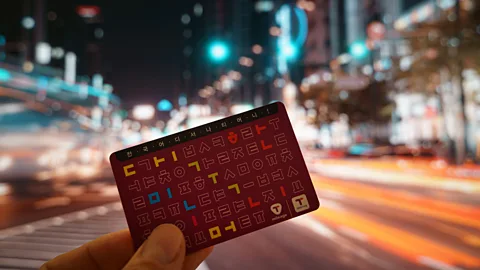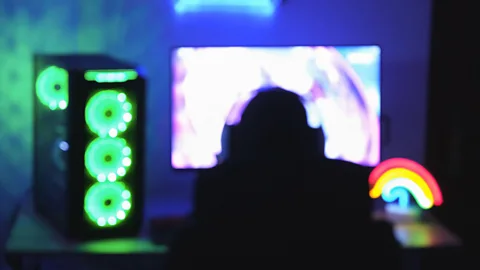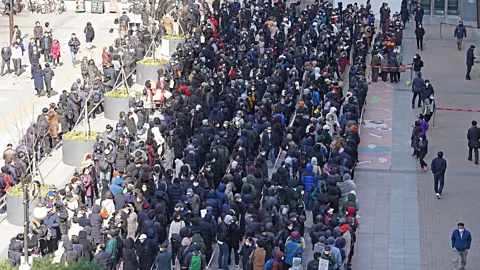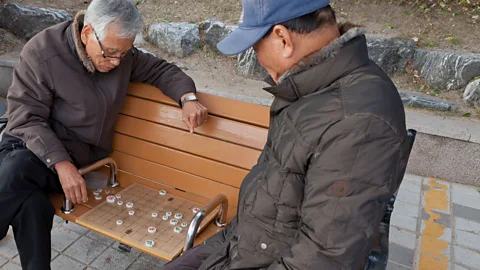The South Koreans left behind in a contact-free society
 Alamy
AlamyDigital technology has helped South Koreans cope with the pandemic. But the elderly have been left behind in the new contact-free era
Like many people around the world, Lee Ye-rin has spent most of the last few months alone at home. Due to the coronavirus pandemic, the 32-year-old office worker now works remotely from her apartment in Seoul; she avoids going to the gym by training at home and streams films on her TV rather than going to the cinema. She reads e-books instead of going to the library, which has been closed during the pandemic anyway. “I have rarely eaten out since the outbreak,” Lee says. “Instead, I order a variety of takeaway meals and even ice-cream for dessert on a delivery app. When I am fed up with that, I order ingredients from the grocery store and cook at home.”
This isolated way of life has become the ‘new normal’ for many since lockdowns and shelter-in-place orders were introduced. But for South Koreans, it’s been on its way since even before Covid-19 hit. In fact, there’s even a word for it.
‘Untact’ – a combination of the prefix ‘un’ and the word ‘contact’ – has been floating around in marketing circles since 2017. It describes doing things without direct contact with others, such as using self-service kiosks, shopping online or making contactless payments. Some believe this is a natural progression in a modern society like South Korea, which combines robotic baristas, virtual make-up studios and digital financial transactions with an ageing population and a shrinking labour force.
 Alamy
AlamySince the Covid-19 outbreak, ‘untact’ has moved from being a buzzword to becoming a central government policy. President Moon Jae-in’s recently announced “New Deal” economic plan includes a pledge to “promote untact industries” such as remote health and senior care, virtual offices and e-commerce support for small businesses.
More like this:
A recent local survey by job search engine Saramin showed that 71.6% of South Korean adults felt their ‘untact’ economic activities had increased as a direct result of the pandemic. Yet in what is considered to be one of the most technologically advanced countries, the rapid rise of a minimal-contact society has left a swathe of elderly people behind.
Mastering connected life
While South Korea has impressive high-speed internet infrastructure with an internet penetration rate of nearly 96%, according to a 2019 survey conducted by the National Information Society Agency (NIA) only 29.2% of people in their 60s and older said they could install and use mobile applications and only 22.7% said they used e-commerce. In fact, research from the University of Greenwich found that the most frequently used functions used by over-60s in South Korea were making phone calls and checking the time. Compare that to Korea’s 30-39-year-olds whose level of internet usage is at 100%, with those between 10 and 29 years of age at 99.9%.
 Alamy
AlamyThe digital divide is a social issue faced by countries worldwide. While there’s no doubt that socio-economic factors limiting physical access to the technology are a barrier to many, there’s also the issue of helping people who do have access learn how to use it. The same NIA survey found that access to digital devices among the information-vulnerable class – which includes people with disabilities, the elderly and those on low-incomes - was 97.1%, confirming that most South Koreans have a computer or a smartphone.
That means the nation’s digital gap isn’t just between the have and have-nots, it’s between those who can use their devices and those who can’t. And when the pandemic hit, presenting a raft of challenges and digital coping mechanisms, the problem of that digital divide – and who could and could not thrive in an ‘untact’ society – was laid bare.
Vital information, important entertainment
South Korea is broadly considered to have been successful in its fight against Covid-19 and technology has played a key role. An effective contact tracing system was put in place, digital maps were widely distributed to help people keep track of the spread of Covid-19 as well as provide information on the location of patients and those with whom they had been in contact. Some navigated the digital technology, which was introduced to make information more available to the public, much better than others.
One example: there was a "mask crisis" in the early phase of the epidemic. As massive crowds formed queues at shops, new mobile applications and websites sprang up listing real-time mask inventory from retailers. Young people were able to use this information to find masks easily, while many elderly people had to take their chances with their local pharmacies.
 Alamy
AlamyChung Hyang-sook, 71, says she waited in a queue for over an hour to buy a mask but they were sold out once she reached the front, and she went home empty-handed. "I heard there are mask inventory apps, but it's difficult for older people to use. At our age, it's faster to just go to the store than to check the mobile apps,” she says.
Then there was the question of how to spend the long days of lockdown. Social distancing measures have greatly reduced face-to-face activities but this doesn’t seem to have had a particularly negative impact on younger digital natives. Some even think their new “untact” way of life is better than the old way.
Beon Gi-yeong, a graduate student in Seoul, has been enjoying online art exhibitions and virtual live concerts since the Covid-19 outbreak, and says the her access to the arts has actually improved. “Recently, there was a live-stream performance of Swan Lake at the [LG Arts Center] for two days. I've always wanted to see Matthew Bourne's Swan Lake performance, and I had a chance to see the superb performance for free. I also watched a YouTube recital by pianist Cho Sung-jin in April,” says Beon.
Many elderly people, however, are struggling as they adapt to lives isolated from their usual support systems. Most local senior citizen centres, where the elderly can socialise, are closed and according to a survey by Hankook Research, 97% of senior citizens in their 60s and older said they refrained from going out after the outbreak.
"I've been stuck at home alone for months,” says 79-year-old Choi Byung-wan, who lives alone in Seoul. Pre-coronavirus, he was a regular at his local senior centre but since early February he has stayed put. Choi is fearful of getting the virus and only ventures out when he absolutely has to get groceries or go to a hospital appointment.
 Alamy
AlamyWhile he has a smartphone, he isn’t able to navigate the new landscape of virtual activities keeping the younger generation occupied. To pass the time he watches television and clicks on links to YouTube videos that he is sent via Kakaotalk (the Korean version of WhatsApp) on his phone. “There isn’t much I can do so I just spend all day watching TV,” he says. “The welfare centre often calls me to say hello, and that is the only joy for me these days.”
Inclusivity as a necessity
The digital divide is not a new problem in South Korea, says Park Chang-ho, a professor of information sociology at Soongsil University in Seoul. “When buying train tickets at Seoul station for example, only the elderly line up at the ticket counter because they are not used to digital devices like ticket kiosks,” he says. “The problem has existed before, but coronavirus has highlighted the issue.”
It’s a problem of which the South Korean government is all too aware. Science and ICT Minister Choi Ki-young has acknowledged the need for an inclusive digital economy, warning that the digital divide “could widen the social gap even further”, particularly in the coronavirus era. There’s also the question of vital information getting to where it is needed. In a recent survey, 83% of participants predicted that the information gap would get worse in the post-coronavirus era, while 65% said that official information was not evenly delivered to everyone during the pandemic.
In the past, policy-makers have mostly focused on improving people’s access to digital devices. On this front, they have succeeded. But Park Chang-Ho also thinks that recent events have shifted public attitudes towards the importance of an inclusive digital landscape. “In the past, if the government talked about fostering a digital-friendly environment, some would push back and say ‘what do we do with senior citizens who are not familiar with digital?’,” he says. “But now it seems that many people have come to naturally accept the necessity of it in the social environment.”
There are plans to establish 1,000 digital education centres across the country as well as hire people to teach digital literacy skills. As elderly people are still being encouraged to stay at home, Choi says the government’s New Deal policy also aims to facilitate technology they can use by themselves, like a digital device that senses their blood pressure and pulse, to flag up if they need a check-up or home visit.
The pandemic has shown that any ‘untact’ future in South Korean will be about much more than online shopping. It will be about the equal distribution of information among all demographics, the ability to stay connected to health and social services, and the knowledge that ‘non-contact’ doesn’t mean leaving behind the vulnerable in society.
"The government has no choice but to pay attention to such issues now,” says Park. And if they get it right, it could give the rest of the world a glimpse into future societies everywhere.
